| |
|
St Peter,
West Lynn
 |
|
It was good to come back
to West Lynn after ten years away. Back in 2006
it had seemed a separate place, but ten years on
it was quite clear that the prosperity of Kings
Lynn was spreading westwards to grasp it
avariciously. So many east coast ports are in
decline, but King's Lynn seems to go from
strength to strength, which can only be explained
by its position on a railway line into Cambridge
and then swiftly on to London.
That day in 2006, we had driven right across
Norfolk as it was waking up on a Saturday morning
- well, a bit later than that; let's say it was
washing up after breakfast, putting its shoes on
and then going shopping. The whole of the Ouse
Valley was pouring into Kings Lynn, looking for a
parking place, and we were glad to be crossing
the river and heading into the Marshlands. First
stop was up the west bank of the Ouse, and just a
stones throw from the centre of Lynn itself.
Talking of throwing stones, West Lynn was a
fairly rough place in those days. The shop beside
St Peter had razorwire barriers like I'd seen in
the Shankill in west Belfast the previous month,
and I’d not seen so much graffiti on the
outside of a church before. The west window was
completely boarded up. |
Not surprisingly, the
church was locked, with a keyholder in the adjacent
close. He opened the door to us after about six hours and
glared out with what I took to be typical marshland
reticence. When I asked for the key, he said
“Why?” but fortunately I knew the answer to
this question, because West Lynn has a seven-sacrament
font. Knowing he’d been beaten, he gave in and
smiled, giving us the key graciously.
Coming back, the
church was still locked. But there was a different
keyholder. She was very nice, and didn't quiz me as to my
motives.
The exterior of the church is interesting. Cruciform, as
many churches are around here, the chancel is an addition
of the 1930s by the aged Walter Caroe, and looks very
much of that decade. It reminded me of Dilham. Old
tracery has been built into the walls, and the tracery
replicates the 19th century window (and contains its
glass) that once was set in the blocked chancel arch.
Despite the cement-rendering to tower and transepts,
there is a nice mix of flint and red-brick, and a little
carstone too. A 1920s vestry opposite the red-brick Tudor
porch completes the piece.
We let ourselves in to what turns out to be a very high
church – the main Sunday service still styles itself
Mass, and the Vicar is Father someone-or-other.
There’s also evidence of this in the furnishings,
including devotional statues and the like, but I didn't
get the impression that the church gets used much for
private devotions; there were certainly no candles
burning. Perhaps it is an enthusiasm of the Vicar’s
rather than of the parish as a whole.
The font is a delight – probably the most primitive
of the series after Wendling's, the figures like cartoon
characters. It has been repaired with darker cement, so
you can see what is original and what isn’t, and it
is actually relatively unvandalised. The Priest hearing
confession is wearing a cowl or hood, as was the
convention of the medieval period, but in this case it
doesn't half make him look Mother Teresa. The Mass panel,
seen from the side on, is absolutely crowded with
figures, some standing and kneeling to the left of the
rood screen, which is seen end on, and the Priest
elevating the host to the right. In the Baptism panel,
the baby is held upside down. The eighth panel depicts
the Holy Trinity (not, as Pevsner has it, 'Christ
Enthroned', or Mortlock's 'God the Father').
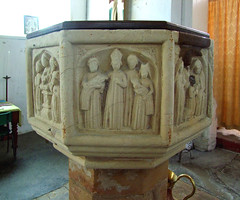 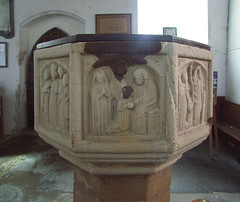    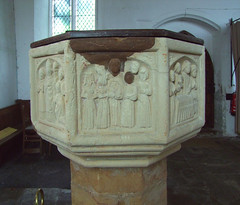 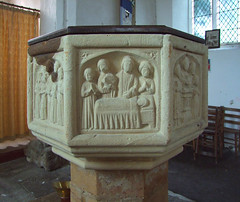 
There is a splendid
brass of a priest, Adam Outlaw (what a great name for the
fens!) and the benches are a not unpleasing mix of 15th,
17th and 19th century work, most of a local quality.
Perhaps best are some poppyheads reminiscent of those in
the chancel at Walpole St Peter. The misericords are
fascinating - they appear to have suffered the attention
of iconoclasts, but also do not seem as old as they
pretend.
The north transept is fitted out as a lady chapel, both
elegant and seemly. There is a bold squint through to the
high altar with its grand reredos. Indeed, the fittings
of the sanctuary are all boldly 20th century
Anglo-catholic, and the sedilia and piscina an exercise
in modernist devotion. The whole piece is triumphant, but
poignant too, the beleaguered anglo-catholic movement of
the CofE in its last days. It looked lovely, but it
reminded me of churches which I'd known years ago which
had since lost this tradition, which made me feel a bit
sad. Here, everything was done well, but it was fading,
and would fade out. I was glad I'd come back now.
Simon Knott, September 2016
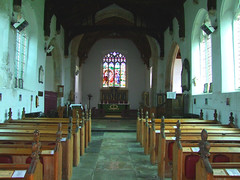 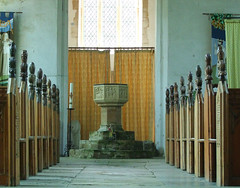 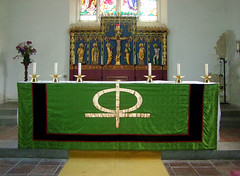
 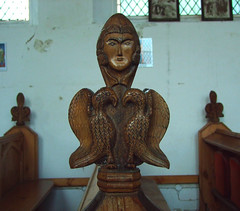 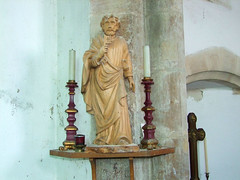
 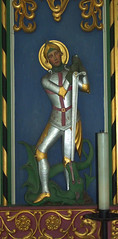 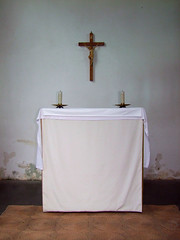  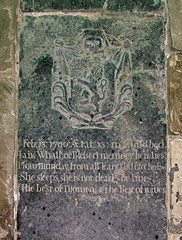
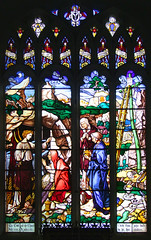 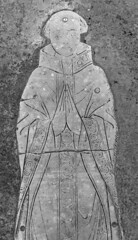 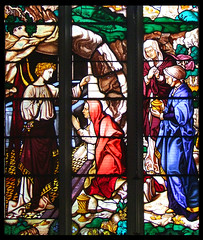

Amazon commission helps cover the running
costs of this site.
|
|
|
